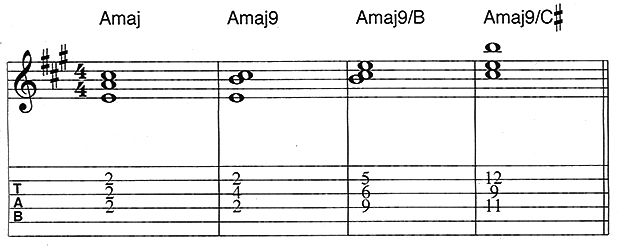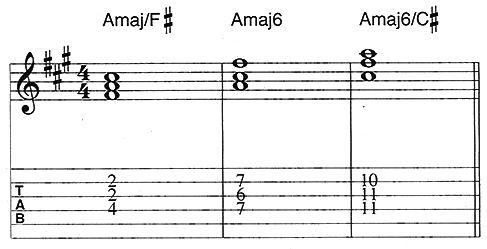Tired Triads? Breathe New Life into Tried-and-True Chord Shapes
It’s easier than you think to liven up any chord voicing that might have gotten a little stale.

Whether in music or life, it’s nice to have options.
If you know only one A chord, for example, you’ll play only that one A chord whenever the need arises. However, there are many things you can do to subtly change the tried-and-true Amaj. The major triad is made up of the root, 3rd, and 5th.
In this lesson, we’re going to hear what happens if we try substituting the root and 5th with other notes, such as the 2nd/9th, 4th/11th, or 6th/13th. Each of these chords can obviously benefit from an open-A string, although the fretted-only fingerings here can be moved anywhere on the neck.
In Figure 1, we begin with a second inversion A chord. Replace the root with the 9th, and the character of the voicing (now spelled, low to high, E, B, C#) changes noticeably.
Invert the second inversion triad on the same string set (second, third, fourth), and the order will be B, C#, E. Invert the voicing again and the order will be C#, E, B. As we climb up the neck rearranging these three notes, it’s easy to hear the different flavor of each voicing.

Figure 2 features a sus4 chord: low to high, E, A, D. Make it an add4 chord by replacing the 5th (E) with the 3rd (C#). Dig the clangy minor second between the 3 and the 4. Then invert that voicing.

The pattern continues in Figure 3. I remove the 5th from the triad and replace it with the 6th scale degree. You might think that these are F#m chords, and you’re right, but over an open-A string you’ll hear the difference – these add an uptown elegance to a normal progression in the key of A. Invert the triad along the same string set.
All the latest guitar news, interviews, lessons, reviews, deals and more, direct to your inbox!
Once you get started on this concept, you’ll see that it’s easy to liven up any chord voicing that might have gotten a little stale.

